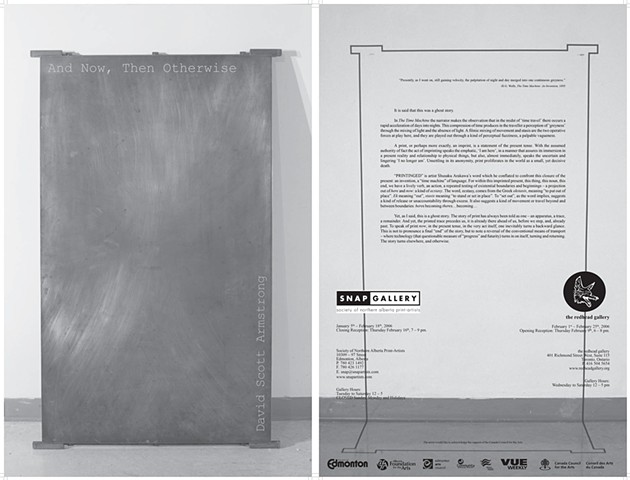Writing
Poster project accompanying the exhibition And Now, Then Otherwise, shown at the RedHead Gallery, Toronto, and the SNAP Gallery, Edmonton.
“Presently, as I went on, still gaining velocity, the palpitation of night and day merged into one continuous greyness.”
-H.G. Wells, The Time Machine: An Invention, 1895
It is said that this was a ghost story.
In The Time Machine the narrator makes the observation that in the midst of ‘time travel’ there occurs a rapid acceleration of days into nights. This compression of time produces in the traveller a perception of ‘greyness’ through the mixing of light and the absence of light. A filmic mixing of movement and stasis are the two operative forces at play here, and they are played out through a kind of perceptual fuzziness, a palpable vagueness.
A print, or perhaps more exactly, an imprint, is a statement of the present tense. With the assumed authority of fact the act of imprinting speaks the emphatic, ‘I am here’, in a manner that assures its immersion in a present reality and relationship to physical things, but also, almost immediately, speaks the uncertain and lingering ‘I no longer am’. Unsettling in its anonymity, print proliferates in the world as a small, yet decisive death.
“PRINTINGED” is artist Shusaku Arakawa’s word which he conflated to confront this closure of the present: an invention, a “time machine” of language. For within this imprinted present, this thing, this noun, this end, we have a lively verb, an action, a repeated testing of existential boundaries and beginnings – a projection out of here and now: a kind of ecstasy. The word, ecstasy, comes from the Greek ekstasis, meaning “to put out of place”. Ek meaning “out”, stasis meaning “to stand or set in place”. To “set out”, as the word implies, suggests a kind of release or unaccountability through excess. It also suggests a kind of movement or travel beyond and between boundaries: heres becoming theres…becoming…
Yet, as I said, this is a ghost story. The story of print has always been told as one – an apparatus, a trace, a remainder. And yet, the printed trace precedes us, it is already there ahead of us, before we step, and, already past. To speak of print now, in the present tense, in the very act itself, one inevitably turns a backward glance. This is not to pronounce a final “end” of the story, but to note a reversal of the conventional means of transport – where technology (that questionable measure of “progress” and futurity) turns in on itself, turning and returning. The story turns elsewhere, and otherwise.
